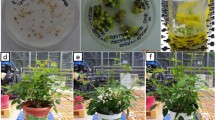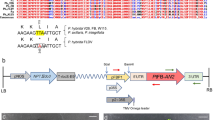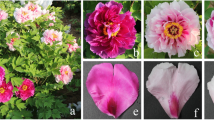Abstract
Aquilegia buergeriana is a native plant in Korea with blue flowers. Flavonoid 3′,5′ hydroxylase (F3′5′H) is a key gene involved in the synthesis of delphinidin pigment responsible for the flower's blue color. We isolated the F3′5′H from the petals of A. buergeriana (AbF3′5′H) and introduced the AbF3′5′H gene into Petunia hybrida using Agrobacterium-mediated transformation. Forty-five plants were acquired from a kanamycin-supplemented medium. Fifteen of these were identified as transgenic plants using polymerase chain reaction (PCR). Quantitative real-time PCR (qRT-PCR) analysis revealed that the AbF3′5′H was expressed in the petal, corolla tube, and stigma of P. hybrida. AbF3′5′H-transgenic plant (T0) flower color was darker than that of non-transgenic plants (NTs). Particularly, the stigma color was dramatically changed, from light yellow green (145C) to purple (N77C or N79D). The segregation ratio of the three transgenic (T1) lines was identified as 3:1 by PCR analysis of AbF3′5′H and neomycin phosphotransferase-II. The flower color change of the transgenic lines (T1) was similar to that of T0. qRT-PCR analysis showed that AbF3′5′H-transgenic T1 lines had a higher AbF3′5′H expression than NT in all floral organs. Moreover, delphinidin was confirmed to be accumulated in both corolla tube and stigma and was enhanced in the petals of AbF3′5′H-transgenic T1 lines through UPLC analysis. Our findings indicate the role of AbF3′5′H in flower color change. These results also indicate the functionality of AbF3′5′H in bluish flower modifications.






Similar content being viewed by others
References
Ahn SY, Kang KK, Yun HK, Park HG (2011) Progeny analysis and selection of Tomato transformants with patII gene linked to inherent disease resistance gene. Hortic Sci Technol 29:345–351
Brugliera F, Tao GQ, Tems U, Kalc G, Mouradova E, Price K, Stevenson K, Nakamura N, Stacey I, Katsumoto Y, Tanaka Y, Mason JG (2013) Violet/blue chrysanthemums-metabolic engineering of the anthocyanin biosynthetic pathway results in novel petal colors. Plant Cell Physiol 54:1696–1710. https://doi.org/10.1093/pcp/pct110
Celli GB, Tan C, Selig MJ (2019) Anthocyanidins and anthocyanins. Encyclopedia of food chemistry. Elsevier, New York, pp 218–223. https://doi.org/10.1016/B978-0-12-814026-0.21780-0
Chandler SF, Sanchez C (2012) Genetic modification; the development of transgenic ornamental plant varieties. Plant Biotechnol 10:891–903. https://doi.org/10.1111/j.1467-7652.2012.00693.x
Donnarumma F, Paffetti D, Fladung M, Biricolti S, Dieter E, Altosaar I, Vettori C (2011) Transgene copy number estimation and analysis of gene expression levels in Populous spp. transgenic lines. BMC Proc 5:P152. https://doi.org/10.1186/1753-6561-5-S7-P152
Falginella L, Castellarin SD, Testolin R, Gambetta GA, Morgante M, Gaspero GD (2010) Expansion and subfunctionalisation of flavonoid 3′,5′-hydroxylases in the grapevine lineage. BMC Genom 11:562. https://doi.org/10.1186/1471-2164-11-562
Han X, Luo Y, Lin J, Wu H, Sun H, Zhou L, Chen S, Guan Z, Fang W, Zhang F, Chen F, Jiang J (2021) Generation of purple-violet chrysanthemums via anthocyanin B-ring hydroxylation and glucosylation introduced from Osteospermum hybrida F3′5′H and Clitoria ternatea A3′5′GT. Ornamental Plant Res 1:4
He H, Ke H, Keting H, Qiaoyan X, Silan D (2013) Flower colour modification of chrysanthemum by suppression of F3′H and overexpression of the exogenous Senecio cruentus F3′5′H Gene. PLoS ONE 8:e74395. https://doi.org/10.1371/journal.pone.0074395
Holton TA (1995) Modification of flower color via manipulation of P450 gene expression in transgenic plants. Drug Metabol Drug Interact 12:3–4. https://doi.org/10.1515/DMDI.1995.12.3-4.359
Katsumoto Y, Fukuchi-Mizutani M, Fukui Y, Brugliera F, Holton TA, Karan M, Nakamura N, Yonekura-Sakakibara K, Togami J, Pigeaire A, Tao GC, Nehra NS, Lu CY, Dyson BK, Tsuda S, Ashikari T, Kusumi T, Mason JG, Tanaka O (2007) Engineering of the rose flavonoid biosynthetic pathway successfully generated blue-hued flowers accumulating delphinidin. Plant Cell Physiol 48:1589–1600. https://doi.org/10.1093/pcp/pcm131
Kim DH, Park SK, Park BR, Lee JY, Lim SH (2018) Flavonoid metabolic engineering for modification of flower color in chrysanthemum. Korean Breed Sci 50:351–363. https://doi.org/10.9787/KJBS.2018.50.4.351
Lee SY, Cheon KS, Kim SY, Shin JY, Lee YA, Ramya MR, Kang YI, Park PH, Park PM, An HR (2017) Functional expression of Flavonoid 3′,5′-hydroxylase (F3′5′H) gene isolated from Clematis patens in petunia. Flower Res 25:246–252. https://doi.org/10.11623/frj.2017.25.4.09
Lee SY, Park PH, Park PM, An HR, Kang YI, Choi YJ, Lee YR (2019) Novel gene from Aquilegia buergeriana having function of differentiating petal, pistil and center color of flowering plant. Republic of Korea Patent 10-2010833
Mancinelli AL (1984) Photoregulation of anthocyanin synthesis: VIII. Effect of light pretreatments. Plant Physiol 75:447–453. https://doi.org/10.1104/pp.75.2.447
Murashige T, Skoog F (1962) A revised medium for rapid growth and bio assays with tobacco tissue cultures. Plant Physiol 15:473–497. https://doi.org/10.1111/j.1399-3054.1962.tb08052.x
Nakamura M, Katsumoto Y, Brugliera F, Demelis L, Nakajima D, Suzuki H, Tanaka Y (2015) Flower color modification in Rosa hybrida by expressing the S-adenosylmethionine: anthocyanin 3′,5′-O-methyltransferase gene from Torenia hybrida. Plant Biotechnol 32:109–117. https://doi.org/10.5511/plantbiotechnology.15.0205a
Noda N, Yoshioka S, Kishimoto S, Nakayama M, Douzono M, Tanaka Y, Aida R (2017) Generation of blue chrysanthemums by anthocyanin B-ring hydroxylation and glycosylation and its coloration mechanism. Sci Adv 3:e1602785. https://doi.org/10.1126/sciadv.1602785
Okinaka Y, Shimada Y, Nakano-Shimada R, Ohbayashi M, Kiyokawa S, Kikuchi Y (2003) Selective accumulation of delphinidin derivatives in tobacco using a putative flavonoid 3′,5′-hydroxylase cDNA from Campanula medium. Biosci Biotechnol Biochem 67:165. https://doi.org/10.1271/bbb.67.161
Provenzano S, Spelt C, Hosokawa S, Nakamura N, Brugliera F, Demelis L, Geerk DP, Schubert A, Tanaka Y, Quattrocchio F, Koes R (2014) Genetic control and evolution of anthocyanin methylation. Plant Physiol 165:962–977. https://doi.org/10.1104/pp.113.234526
Qi Y, Lou Q, Quan Y, Liu Y, Wang Y (2013) Flower-specific expression of the Phalaenopsis flavonoid 3′, 5′-hydoxylase modifies flower color pigmentation in Petunia and Lilium. Plant Cell Tiss Organ Cult 115:263–273. https://doi.org/10.1007/s11240-013-0359-2
Shimada Y, Ritsuko NS, Masaya O, Yasushi O, Shigeto K, Yasuhiro K (1999) Expression of chimeric P450 genes encoding flavonoid-3′,5′-hydroxylase in transgenic tobacco and petunia plants. FEBS Lett 461:241–245. https://doi.org/10.1016/s0014-5793(99)01425-8
Southern EM (1975) Detection of specific DNA sequences among fragments separated by gel electrophoresis. J Mol Biol 98:503–517. https://doi.org/10.1016/s0022-2836(75)80083-0
Sun W, Meng X, Liang L, Li Y, Zhou T, Cai X, Wang L, Gao X (2017) Overexpression of a Freesia hybrida flavonoid 3-O-glycosyltransferase gene, Fh3GT1, enhances transcription of key anthocyanin genes and accumulation of anthocyanin and flavonol in transgenic petunia (Petunia hybrida). In Vitro Cell Dev Biol Plant 53:478–488. https://doi.org/10.1007/s11627-017-9836-3
Tanaka Y (2006) Flower colour and cytochromes P450. Phytochem Rev 5:283–291. https://doi.org/10.1007/s11101-006-9003-7
Tanaka Y, Brugliera F (2013) Flower colour and cytochromes P450. Phil Trans R Soc B 368:20120432. https://doi.org/10.1007/s11101-006-9003-7
Tanaka Y, Brugliera F, Chandler S (2009) Recent progress of flower colour modification by biotechnology. Int J Mol Sci 10:5350–5369. https://doi.org/10.3390/ijms10125350
Tanaka Y, Brugliera F, Kalc G, Senior M, Dyson B, Nakamura N, Katsumoto Y, Chandler S (2010) Flower color modification by engineering of the flavonoid biosynthetic pathway: practical perspectives. Biosci Biotechnol Biochem 74:1760–1769. https://doi.org/10.1271/bbb.100358
Tsuda S, Fukui Y, Nakamura N, Katsumoto Y, Yonekura-Sakakibara K, Fukuchi-Mizutani M, Ohira K, Ueyama Y, Ohkawa H, Holton TA, Kusumi T, Tanaka Y (2004) Flower color modification of Petunia hybrida commercial varieties by metabolic engineering. Plant Biotechnol 21:377–386. https://doi.org/10.5511/PLANTBIOTECHNOLOGY.21.377
Vain P, Afolabi AS, Worland B, Snape JW (2003) Transgene behavior in populations of rice plants transformed using a new dual binary vector system: pGreen/pSoup. Theor Appl Genet 107:210–217. https://doi.org/10.1007/s00122-003-1255-7
Wang YS, Xu YJ, Gao LP, Yu O, Wang XZ, He XJ, Jiang XL, Liu YJ, **a T (2014) Functional analysis of flavonoid 3′,5′-hrdeoxylase from Tea plant (Camelia sinensis): critical role in the accumulation of catechins. BMC Plant Biol 14:347. https://doi.org/10.1186/s12870-014-0347-7
Wang CK, Chin YC, Lin CY, Chen PY, To KY (2015) Transforming the snapdragon aurone biosynthetic genes into petunia alters coloration patterns in transgenic flowers. Adv Biosci Biotechnol 06:702–722. https://doi.org/10.4236/abb.2015.612073
Yang L, Ding J, Zhang C, Jia J, Weng H, Liu W, Zhang D (2005) Estimating the copy number of transgenes in transformed rice by real-time quantitative PCR. Plant Cell Rep 23:759–763. https://doi.org/10.1007/s00299-004-0881-0
Yao Q, Cong L, Chang JL, Li KX, Yang GX, He GY (2006) Low copy number gene transfer and stable expression in a commercial wheat cultivar via particle bombardment. J Exp Bot 14:3737–3746. https://doi.org/10.1093/jxb/erl145
Yeon JY, Kim WS (2020) Floral pigment-scent associations in eight cut rose cultivars with various petal colors. Hortic Environ Biotechnol 61:633–641. https://doi.org/10.1007/s13580-020-00249-3
Zhang H, Koes R, Shang H, Fu Z, Wang L, Dong X, Zhang J, Passeri V, Li Y, Jiang H, Gao J, Li Y, Wang H, Quattreocchio FM (2019) Identification and functional analysis of three new anthocyanin R2R3-MYB genes in petunia. Plant Direct 3:e00114. https://doi.org/10.1186/s12870-014-0347-7
Zhang Y, Zhang Y, Duan X, Liu X, Yuan S, Han J, Cheng Y (2020) Anthocyanins in tree peony (Paeonia suffruticosa) and their relationship with flower color. Hortic Sci Technol 38:776–784. https://doi.org/10.7235/HORT.20200070
Zheng T, Tan W, Yang H, Zhang L, Li T, Liu B, Zhang D, Lin H (2019) Regulation of anthocyanin accumulation via MYB75/HAT1/TPL-mediated transcriptional repression. PLoS Genet 15:e1007993. https://doi.org/10.1371/journal.pgen.1007993
Acknowledgements
This study was carried out with the support of “Research Program for the National Institute of Horticultural and Herbal Science (Project No. PJ01607001)”, Rural Development Administration, Republic of Korea
Author information
Authors and Affiliations
Contributions
YAL obtained and managed AbF3′5′H-transgenic (T1) petunia lines and performed PCR and qRT-PCR analysis, JYS and SYL obtained and managed AbF3′5′H-transgenic (T0) petunia plants, KSC cloned the AbF3′5′H gene, JHK performed the Southern blot analysis, BS performed UPLC analysis, and others (HRA, YJL, PMP, and JL) analyzed phenotypic characteristics data of AbF3′5′H-transgenic petunia plants.
Corresponding author
Ethics declarations
Conflict of interest
The authors declare that they have no conflict of interest.
Additional information
Communicated by Seon-In Yeom.
Publisher's Note
Springer Nature remains neutral with regard to jurisdictional claims in published maps and institutional affiliations.
Rights and permissions
Springer Nature or its licensor (e.g. a society or other partner) holds exclusive rights to this article under a publishing agreement with the author(s) or other rightsholder(s); author self-archiving of the accepted manuscript version of this article is solely governed by the terms of such publishing agreement and applicable law.
About this article
Cite this article
Lee, Y.A., Cheon, K.S., Shin, J.Y. et al. Flower color modification through expression of Aquilegia buergeriana F3′5′H in Petunia hybrida. Hortic. Environ. Biotechnol. 64, 683–694 (2023). https://doi.org/10.1007/s13580-022-00505-8
Received:
Revised:
Accepted:
Published:
Issue Date:
DOI: https://doi.org/10.1007/s13580-022-00505-8




